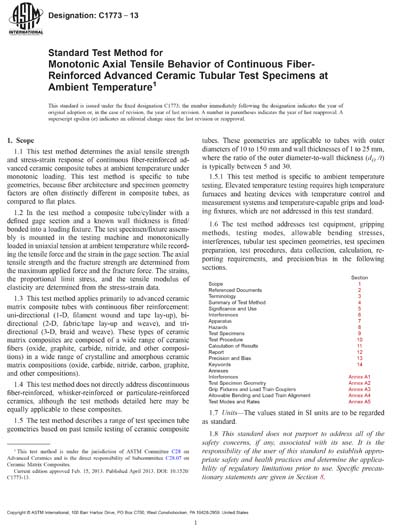Historical
ASTM C1773-13
Standard Test Method for Monotonic Axial Tensile Behavior of Continuous Fiber-Reinforced Advanced Ceramic Tubular Test Specimens at Ambient Temperature
1.1 This test method determines the axial tensile strength and stress-strain response of continuous fiber-reinforced advanced ceramic composite tubes at ambient temperature under monotonic loading. This test method is specific to tube geometries, because fiber architecture and specimen geometry factors are often distinctly different in composite tubes, as compared to flat plates.
1.2 In the test method a composite tube/cylinder with a defined gage section and a known wall thickness is fitted/bonded into a loading fixture. The test specimen/fixture assembly is mounted in the testing machine and monotonically loaded in uniaxial tension at ambient temperature while recording the tensile force and the strain in the gage section. The axial tensile strength and the fracture strength are determined from the maximum applied force and the fracture force. The strains, the proportional limit stress, and the tensile modulus of elasticity are determined from the stress-strain data.
1.3 This test method applies primarily to advanced ceramic matrix composite tubes with continuous fiber reinforcement: uni-directional (1-D, filament wound and tape lay-up), bi-directional (2-D, fabric/tape lay-up and weave), and tri-directional (3-D, braid and weave). These types of ceramic matrix composites are composed of a wide range of ceramic fibers (oxide, graphite, carbide, nitride, and other compositions) in a wide range of crystalline and amorphous ceramic matrix compositions (oxide, carbide, nitride, carbon, graphite, and other compositions).
ASTM International [astm]

